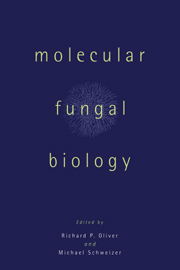Book contents
- Frontmatter
- Contents
- List of contributors
- Preface
- 1 Fungi: important organisms in history and today
- 2 Fungal phylogeny
- 3 The yeast Saccharomyces cerevisiae: insights from the first complete eukaryotic genome sequence
- 4 Interactions between pathway-specific and global genetic regulation and the control of pathway flux
- 5 Hyphal cell biology
- 6 Asexual sporulation: conidiation
- 7 Fungal cell division
- 8 Sexual development of higher fungi
- 9 Lignocellulose breakdown and utilization by fungi
- 10 Plant disease caused by fungi: phytopathogenicity
- 11 Fungi as animal pathogens
- 12 Biotechnology of filamentous fungi: applications of molecular biology
- Index
4 - Interactions between pathway-specific and global genetic regulation and the control of pathway flux
Published online by Cambridge University Press: 05 June 2012
- Frontmatter
- Contents
- List of contributors
- Preface
- 1 Fungi: important organisms in history and today
- 2 Fungal phylogeny
- 3 The yeast Saccharomyces cerevisiae: insights from the first complete eukaryotic genome sequence
- 4 Interactions between pathway-specific and global genetic regulation and the control of pathway flux
- 5 Hyphal cell biology
- 6 Asexual sporulation: conidiation
- 7 Fungal cell division
- 8 Sexual development of higher fungi
- 9 Lignocellulose breakdown and utilization by fungi
- 10 Plant disease caused by fungi: phytopathogenicity
- 11 Fungi as animal pathogens
- 12 Biotechnology of filamentous fungi: applications of molecular biology
- Index
Summary
Introduction
It is evident that living organisms regulate their metabolism in order to balance the conflicting demands of providing building blocks for synthesis and growth whilst at the same time providing energy derived from catabolism. These metabolic pathways are regulated by well-characterized enzymatic methods such as feedback inhibition and, once appropriate levels of enzymes have been provided, can be efficiently regulated at the level of the control of metabolic flux by the myriad of interactions between the enzymes and metabolites. Many essential enzymes and proteins are produced constitutively, but others are regulated at the level of gene transcription and/or translation. It is likely that in the most primitive cells, metabolic pathways evolved before transcription regulatory mechanisms. Transcriptional control may have evolved, therefore, to act as a damping mechanism, smoothing out the effects of more rapid changes caused by the build-up and dissemination of pathway metabolites. Or such regulation may be required to target the production of enzymes to particular tissues or organelles, or to allow the organism to use preferred carbon or nitrogen sources. But one of the driving forces for the cell may have been energy conservation: ensuring that enzymes are only supplied when they are needed, and stopping unnecessary enzyme synthesis. In this possible latter role, the cell has had to develop metabolite recognition mechanisms and signal transduction pathways that are able to sense particular cellular metabolites and couple this to transcription control mechanisms.
- Type
- Chapter
- Information
- Molecular Fungal Biology , pp. 135 - 163Publisher: Cambridge University PressPrint publication year: 1999
- 1
- Cited by

